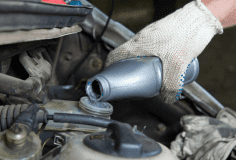Fluid Levels – Are You Your Car’s Best Friend or Its Worst Enemy?
We all know that a dog is man’s best friend, but, what about your car? When it comes to fluid levels – are you your car’s best friend or its worst enemy? If you just jump in, start it up, and head out without ever giving it any thought, you could be not only affecting its overall performance, but shortening its life expectancy as well. Fluids are a vital part of various components that make up your car’s drivetrain and cooling system. Let them get too low and you could be looking at huge repair bills. You wouldn’t drive without car insurance…so, why drive without maintaining the proper fluid levels in your car? Driving without either one will cost you money and problems in the long run.
Needless to say, today’s cars are complicated and require a skilled professional to do the repairs, but simple maintenance doesn’t. And, neither does checking some of the fluid levels under the hood. You can do that yourself, unless you don’t like getting your hands dirty. In that case, be sure to have your local dealership or trusted mechanic perform the service at recommended intervals. For those who don’t mind, here’s what to look for:
1. Engine oil – Driving with no or extremely low oil can and will destroy your engine. Keeping it clean and changing it regularly as recommended will have your engine run properly and efficiently for a long time. To check the oil level, locate and remove the dipstick. With a rag or cloth, wipe it clean, and then reinsert it into the oil reservoir as far as it’ll go. Pull it out again and take a look at the level. If the level is within the acceptable range, simply reinsert it. However, if it’s low on oil and you plan on adding some, be sure it is of the same viscosity suggested by the manufacturer. And, don’t overfill or you could damage the engine. Guidelines usually indicate replacing every 3,000 to 6,000 miles or three to six months, depending on the type of driving you do.
2. Transmission fluid – While transmission fluid doesn’t require changing as often as engine oil, it’s still important to keep it at the proper levels, especially if you tow a boat or recreational trailer. As with the engine oil, locate the transmission dipstick and repeat the procedure. The only difference…is you’ll be checking it with the engine running. The fluid should appear clean, not dark or have a burnt smell. If it does, have it inspected right away. This service should be done every 30,000 miles.
3. Coolant – Never check the fluid in the radiator when the engine is hot. Let it cool down before you check the coolant reservoir (normally a translucent plastic tank located near the radiator). Once the engine has cooled down, check the coolant against the full/low indicators on the side. Again, if you need to add, be sure it’s the correct coolant for your car. Replace every 30,000 to 50,000 miles or every two to three years. If your car is running hot or overheating, have it checked immediately.
4. Power steering fluid –Twist off the top of the reservoir and glance at the small dipstick attached to it. You can check it hot or cold as it’s marked that way. Make sure you look at the right level indicator. If you hear a squealing sound when turning the steering wheel to the left or right it’s probably low and you’ll need to add fluid. The same goes if the level shows it’s low. The suggested service interval for changing it is every 50,000 miles or three years.
5. Brake fluid – You should be able to see through the brake fluid reservoir and check the level indicators on the side or front, usually marked “maximum” and minimum”. Keep in mind that as your brake pads begin to wear, the brake fluid level will drop and require some to be added. Don’t let it get too low as it could affect your braking capabilities.
6. Windshield wiper fluid – Driving around with a filthy windshield can be a safety issue. Checking the washer fluid level is easy. Just look at the marker on the opaque tank or by looking directly into it. Maintain a proper level so you can clean your windshield when needed for added visibility.
The one fluid you can’t really check yourself is the rear differential, which drives the rear wheels. Unless your automotive and mechanical skills are above average, you may want to leave this one to the experts.
Take care of your car by maintaining its fluids at their proper levels and it will be reliable for years to come



